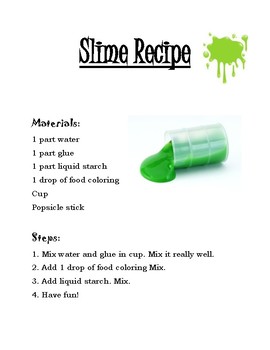Super Simple Slime Recipes for Fun-Filled Parent-Child Bonding!
Welcome, dear creative parents and inquisitive kids! Are you ready to dive into the gooey, stretchy world of homemade slime? Look no further! Today, we’re here with some fantastically easy slime recipes that promise not just a blob of fun but also a wonderful opportunity for parent-child bonding. Perfect for rainy afternoons, science projects, or just because – these slime recipes are sure to bring smiles and giggles to your household.
Why Slime Is a Must-Try for Every Family!
Before we get our hands sticky, let’s chat about why making slime can be such a delightful and educative activity. First off, it’s super easy and most of the ingredients can likely be found in your home right now. Next, it provides a fascinating sensory experience for the kids, helping them discover and learn through touch and play. Plus, it’s a sneaky way to teach some basic science principles! Win-win!
Classic No-Fail Slime Recipe For Beginners
Let’s start with the basics. Our Classic No-Fail Slime is just that – a simple, foolproof recipe that sets the stage for slime-making success! You’ll need:
- 1/2 cup of non-toxic PVA glue (like white school glue)
- 1 1/2 tablespoon of baking soda
- 2 to 3 tablespoons of saline solution (contact lens solution)
Here’s how to whip it up:
- Pour the glue into a bowl.
- Add the baking soda to the glue and mix thoroughly.
- Gradually add in the saline solution, stirring continuously until the slime begins to form and pull away from the sides of the bowl.
- Knead the slime with your hands until it reaches the desired consistency. If it’s too sticky, add more saline solution in small amounts.
TIP: The magic ingredient here is the saline solution, which contains boric acid and sodium borate – these react with the glue, creating the slime’s unique texture.
Colorful Glitter Slime Fun
Once you’ve mastered the No-Fail Slime, it’s time to jazz things up with some glitter! This dazzling version simply adds one extra ingredient to the mix:
- All ingredients from the Classic No-Fail Slime
- Your favorite glitter or confetti (as much as you like!)
The steps are pretty much the same as the classic recipe, but you’ll mix in the glitter or confetti just after you stir in the baking soda. This is an excellent way for your kids to express their creativity by choosing different colors and types of glitter!
Edible Slime Recipe – Safe for the Littlest Hands
With toddlers around, making an edible slime can ease all worries about playtime safety. This recipe uses food-based ingredients, so even if some gets in little mouths, it’s all good.
- 1/4 cup of cornstarch
- 1 tablespoon of non-flavored gelatin
- 1 1/2 cups of water
- Food coloring (optional)
Making this edible slime is a cakewalk:
- Mix the gelatin with half a cup of water until well dissolved.
- In a saucepan, heat the rest of the water over medium heat and add the gelatin mix, stirring continuously.
- Once fully mixed and slightly thick, remove from heat.
- Add the cornstarch and mix until well combined.
- If you choose to add color, this is the moment to mix in some food coloring.
- Let it cool down before handing it over for play – and remember, while it’s safe to eat, it’s not intended as a snack!
NOTE: The texture of edible slime is different from the traditional recipe but still provides a great slimy experience.
There you go, fun-loving families! You’re now equipped with some of the simplest and most entertaining slime recipes around. Ready to get your hands gooey? Stay tuned for our next chapter where we delve into more elaborate recipes and explore the science behind the slime!

5 Essential Tips for Parents Preparing Easy Slime Recipes
As you embark on the exciting journey of creating slime with your kids, there are a few things to keep in mind. Here’s what every parent should know:
- Safety First: While slime is a fantastic project, safety should never be compromised. Ensure that all ingredients used are non-toxic and safe in case of accidental ingestion. However, even with non-toxic ingredients, it’s best to keep slime away from mouths and to supervise young children closely during playtime.
- Preparation is Key: Set up your slime-making area ahead of time. Cover your surfaces with newspaper or a plastic sheet, have all your ingredients measured out, and tools ready. A little prep goes a long way in keeping the process smooth and enjoyable for everyone involved.
- Embrace the Mess: Slime making is a naturally messy process, so gear up for some cleanup afterwards. But don’t let that deter you; the fun and memories created are well worth it. Encourage kids to embrace the mess, too – after all, getting a little sticky is part of the magic of slime!
- Experiment and Customize: The beauty of homemade slime is that you can customize it to your heart’s content – add colors, glitter, beads, or even scents. Encourage your kids to experiment with different add-ins, teaching them the value of creativity and experimentation.
- Patiently Perfect the Slime: Getting the right slime consistency may take some trial and error, so remember to be patient. You might need to add more activator (like saline solution) or more glue – take it slow, mix well, and you’ll eventually hit the slime sweet spot.
The joy of making slime is about more than the end product; it’s about the exciting learning process and the time spent together. Get prepared, get set, and get ready to make some slime-tastic memories!
Frequently Asked Questions (FAQs) on Making Slime
Here are some common questions and concerns that parents may have when creating slime:
- Is homemade slime washable? Yes, most homemade slimes can be cleaned up with warm water and soap. However, the sooner you clean up after play, the easier it will be!
- What if my slime is too runny? If your slime hasn’t firmed up, you may need to add more activator, such as contact lens solution or starch, depending on the recipe.
- Can I make slime without borax? Absolutely! There are many recipes, like those we’ve provided, that use alternatives such as baking soda and saline solution instead.
- How long will the slime last? When stored properly in an airtight container, homemade slime can last several weeks, sometimes even longer. However, if it starts to smell or look moldy, it’s time to throw it out.
- Can making slime be educational? Yes, making slime is not only fun but educational as well. It can teach children about chemistry, measurements, and the properties of different materials.
Keep these tips and FAQs in mind, and don’t forget to capture the precious moments of excitement and amazement on your kids’ faces as they create and play with their own slime. Memories made during these parent-child bonding activities are invaluable and last a lifetime!
See more great Things to Do with Kids in New Zealand here. For more information see here
Disclaimer
The articles available via our website provide general information only and we strongly urge readers to exercise caution and conduct their own thorough research and fact-checking. The information presented should not be taken as absolute truth, and, to the maximum extent permitted by law, we will not be held liable for any inaccuracies or errors in the content. It is essential for individuals to independently verify and validate the information before making any decisions or taking any actions based on the articles.




